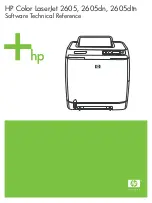
2:576
Volume 2, Part 2: Memory Management
For a long format VHPT, additional steps are required to load bytes 16-23 of the VHPT
entry and check for the correct tag; see
for more details.
A separate structure other than the VHPT may be used to back VHPT translations, in
which case the handler would not use the thash instruction to generate the address of
the translation mapping the VHPT entry corresponding to the original faulting address.
Instead, the handler would use the operating system’s own mechanism for finding VHPT
back-mappings. Other schemes for handling VHPT misses are also possible, but are
beyond the scope of this document.
5.4.3
Alternate Data/Instruction TLB Miss Vectors
These faults are raised when an instruction or data reference misses the processor’s
TLBs and the VHPT walker is not enabled for the faulting address, i.e. TLB misses are
handled entirely in software. Operating systems which do not wish to use the VHPT
walker can disable the walker and use these fault vectors for software TLB fill handlers.
The OS may also choose to enable the walker on a per-region basis and use these
vectors to handle misses in regions where the walker is disabled.
Upon entry to these fault handlers, the IFA and ITIR registers are initialized by the
hardware as follows:
• ITIR – contains the default translation information for the reference which raised
the fault (i.e. for the virtual address contained in IFA). The access key field is set to
the region ID from the RR corresponding to the faulting address. The page size field
is set to the preferred page size (RR.ps) from the RR corresponding to the faulting
address.
• IFA – the virtual address of the bundle (for instruction faults) or data reference (for
data faults) which missed the TLB.
The OS needs to lookup the PTE for the faulting address in the OS page table, convert it
to the architected insertion format (see
Section 4.1.1.5, “Translation Insertion
), and insert it into the TLB. The mechanism used to handle these faults is OS
specific and is beyond the scope of this document.
5.4.4
Data Nested TLB Vector
To enable efficient handling of software TLB fills, the Itanium architecture provides a
dedicated Data Nested TLB fault vector. The Data Nested TLB fault handler is intended
to be used by the Data TLB fault handler, which allows the OS to page the page tables
themselves. When PSR.ic is 0, any data reference that misses the TLB and would
normally raise a Data TLB Miss fault (e.g. a load performed by the Data TLB fault
handler to the page tables) will vector to the Data Nested TLB fault handler instead.
Because IFA is not updated when PSR.ic is 0, the Data Nested TLB fault handler must
get the faulting address from the general register used as the load address in the Data
TLB fault handler
1
. Unlike other nested interruptions, the hardware does
not
update
ISR when a Data Nested TLB fault is delivered.
1.
This requires a register usage convention between all TLB miss handlers and the Data Nested TLB
miss handler.
Summary of Contents for ITANIUM ARCHITECTURE - SOFTWARE DEVELOPERS VOLUME 3 REV 2.3
Page 1: ......
Page 11: ...x Intel Itanium Architecture Software Developer s Manual Rev 2 3 ...
Page 13: ...1 2 Intel Itanium Architecture Software Developer s Manual Rev 2 3 ...
Page 33: ...1 22 Volume 1 Part 1 Introduction to the Intel Itanium Architecture ...
Page 57: ...1 46 Volume 1 Part 1 Execution Environment ...
Page 147: ...1 136 Intel Itanium Architecture Software Developer s Manual Rev 2 3 ...
Page 149: ...1 138 Volume 1 Part 2 About the Optimization Guide ...
Page 191: ...1 180 Volume 1 Part 2 Predication Control Flow and Instruction Stream ...
Page 230: ......
Page 248: ...236 Intel Itanium Architecture Software Developer s Manual Rev 2 3 ...
Page 250: ...2 2 Intel Itanium Architecture Software Developer s Manual Rev 2 3 ...
Page 264: ...2 16 Volume 2 Part 1 Intel Itanium System Environment ...
Page 380: ...2 132 Volume 2 Part 1 Interruptions ...
Page 398: ...2 150 Volume 2 Part 1 Register Stack Engine ...
Page 486: ...2 238 Volume 2 Part 1 IA 32 Interruption Vector Descriptions ...
Page 750: ...2 502 Intel Itanium Architecture Software Developer s Manual Rev 2 3 ...
Page 754: ...2 506 Volume 2 Part 2 About the System Programmer s Guide ...
Page 796: ...2 548 Volume 2 Part 2 Interruptions and Serialization ...
Page 808: ...2 560 Volume 2 Part 2 Context Management ...
Page 842: ...2 594 Volume 2 Part 2 Floating point System Software ...
Page 850: ...2 602 Volume 2 Part 2 IA 32 Application Support ...
Page 862: ...2 614 Volume 2 Part 2 External Interrupt Architecture ...
Page 870: ...2 622 Volume 2 Part 2 Performance Monitoring Support ...
Page 891: ......
Page 1099: ...3 200 Volume 3 Instruction Reference padd Interruptions Illegal Operation fault ...
Page 1295: ...3 396 Volume 3 Resource and Dependency Semantics ...
Page 1296: ......
Page 1302: ...402 Intel Itanium Architecture Software Developer s Manual Rev 2 3 ...
Page 1494: ...4 192 Volume 4 Base IA 32 Instruction Reference FWAIT Wait See entry for WAIT ...
Page 1647: ...Volume 4 Base IA 32 Instruction Reference 4 345 ROL ROR Rotate See entry for RCL RCR ROL ROR ...
Page 1884: ...4 582 Volume 4 IA 32 SSE Instruction Reference ...
Page 1885: ...Index Intel Itanium Architecture Software Developer s Manual Rev 2 3 Index ...
Page 1886: ...Index Intel Itanium Architecture Software Developer s Manual Rev 2 3 ...
Page 1898: ...INDEX Index 12 Index for Volumes 1 2 3 and 4 ...
















































